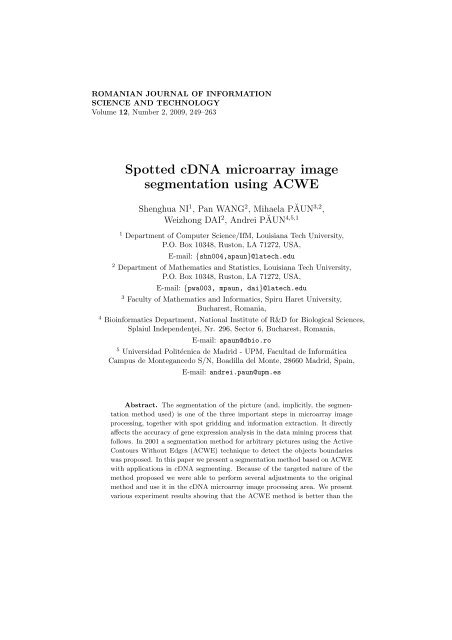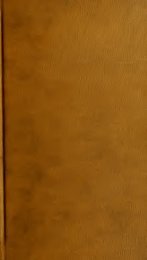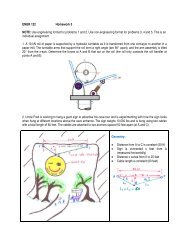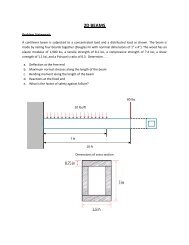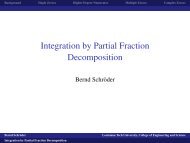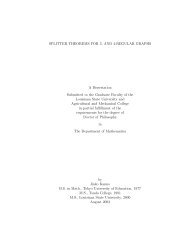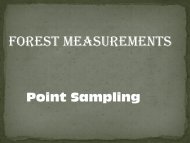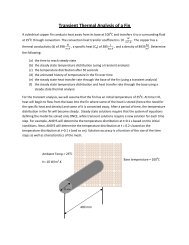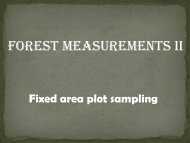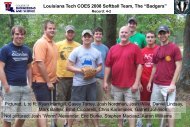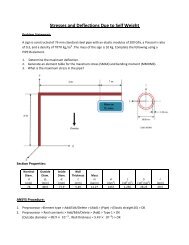Spotted cDNA microarray image segmentation ... - IMT Bucharest
Spotted cDNA microarray image segmentation ... - IMT Bucharest
Spotted cDNA microarray image segmentation ... - IMT Bucharest
- No tags were found...
Create successful ePaper yourself
Turn your PDF publications into a flip-book with our unique Google optimized e-Paper software.
ROMANIAN JOURNAL OF INFORMATIONSCIENCE AND TECHNOLOGYVolume 12, Number 2, 2009, 249–263<strong>Spotted</strong> <strong>cDNA</strong> <strong>microarray</strong> <strong>image</strong><strong>segmentation</strong> using ACWEShenghua NI 1 , Pan WANG 2 , Mihaela PĂUN3,2 ,Weizhong DAI 2 , Andrei PĂUN4,5,11 Department of Computer Science/IfM, Louisiana Tech University,P.O. Box 10348, Ruston, LA 71272, USA,E-mail: {shn004,apaun}@latech.edu2 Department of Mathematics and Statistics, Louisiana Tech University,P.O. Box 10348, Ruston, LA 71272, USA,E-mail: {pwa003, mpaun, dai}@latech.edu3 Faculty of Mathematics and Informatics, Spiru Haret University,<strong>Bucharest</strong>, Romania,4 Bioinformatics Department, National Institute of R&D for Biological Sciences,Splaiul Independenţei, Nr. 296, Sector 6, <strong>Bucharest</strong>, Romania,E-mail: apaun@dbio.ro5 Universidad Politécnica de Madrid - UPM, Facultad de InformáticaCampus de Montegancedo S/N, Boadilla del Monte, 28660 Madrid, Spain,E-mail: andrei.paun@upm.esAbstract. The <strong>segmentation</strong> of the picture (and, implicitly, the <strong>segmentation</strong>method used) is one of the three important steps in <strong>microarray</strong> <strong>image</strong>processing, together with spot gridding and information extraction. It directlyaffects the accuracy of gene expression analysis in the data mining process thatfollows. In 2001 a <strong>segmentation</strong> method for arbitrary pictures using the ActiveContours Without Edges (ACWE) technique to detect the objects boundarieswas proposed. In this paper we present a <strong>segmentation</strong> method based on ACWEwith applications in <strong>cDNA</strong> segmenting. Because of the targeted nature of themethod proposed we were able to perform several adjustments to the originalmethod and use it in the <strong>cDNA</strong> <strong>microarray</strong> <strong>image</strong> processing area. We presentvarious experiment results showing that the ACWE method is better than the
<strong>Spotted</strong> <strong>cDNA</strong> <strong>microarray</strong> <strong>image</strong> <strong>segmentation</strong> using ACWE 2512. Image analysis methods and basic definitionsThere are three steps for <strong>microarray</strong> <strong>image</strong> analysis as described in [8]: addressing,<strong>segmentation</strong> and information extraction. In our research we will not focus onthe addressing part since we can get the grid information for the <strong>microarray</strong> data filefrom the Stanford website mentioned above. A spot is an area where printed <strong>cDNA</strong>is located. Segmentation is a partition process used to separate a spot area from anon-spot area. The spot area is called foreground and the non-spot area is calledbackground. We will focus on four types of <strong>segmentation</strong> methods: fixed circle <strong>segmentation</strong>,adaptive circle <strong>segmentation</strong>, adaptive shape <strong>segmentation</strong> and histogram<strong>segmentation</strong>. Fixed circle <strong>segmentation</strong> is an ideal method, it assumes that eachspot has the same size and a circular shape. The <strong>segmentation</strong> algorithm in this caseis easy to implement but the real spots may not have the perfect circular shape andsame size. Adaptive circle <strong>segmentation</strong> allows for the diameter of each spot circle tobe adjusted. It is better than the fixed circle, but still the spot shape is restricted tobe a circle. Histogram <strong>segmentation</strong> uses the normal distribution of pixels intensitypercentiles around and inside each spot to segment the spot from the background.Obviously this method neglects the particular pixels locations. It will not give outthe accurate spot intensity but only return the trend. Adaptive shape <strong>segmentation</strong>is designed to improve the accuracy of the <strong>segmentation</strong>. This method is better thanthe fixed and adaptive circle <strong>segmentation</strong> methods. Watershed, seed region growingand globally optimal geodesic active contours are the three algorithms usually usedthat fall into the adaptive shape <strong>segmentation</strong> method class. Watershed <strong>segmentation</strong>[3] defines an <strong>image</strong> as a topographic surface and assumes the water enters from theminima and floods the surface. The only visible surface after the flood is called thewatershed lines. Watershed <strong>segmentation</strong> has the weakness of overlaying the original<strong>image</strong>. The <strong>segmentation</strong> area of watershed is always larger than that of the original<strong>image</strong>. Seeded region growing (SRG) segment is a method that starts with someseeds (starting points) and then includes the neighboring pixels to check if they havesimilar intensities. In the affirmative case, the pixels are “joined” together, if not,they will be in different classes. This process will continue until all the pixels havebeen included in a class containing one of the seeds. The weakness of seeds regiongrowing is that if the seeds were chosen improperly the <strong>segmentation</strong> result will notbe accurate. Globally Optimal Geodesic Active Contours (GOGAC) is the new <strong>segmentation</strong>method which was implemented in [10] Spot (fall 2007). The weakness ofthis method is that it prefers to produce circles, it cannot prevent overlaps and it isslower than the SRG method. In what follows we will compare also the <strong>segmentation</strong>results with our implemented method.The <strong>segmentation</strong> method we implemented was based on Active Contours WithoutEdges (ACWE) method, which was proposed by Tony F. Chan and Luminita A. Vesein [4]. Chan and Vese (C-V) model is segmenting an <strong>image</strong> by detecting differentobjects boundary. The authors assumed an <strong>image</strong> was formed by two regions withinand outside an object. Their model can find out objects within an <strong>image</strong> without anydefinition of gradient. The algorithm as described in [4] is as follows:
252 S. Ni et al.Algorithm:1. Initialize φ 0 by φ 0 , n = 0.2. Compute c 1 (φ n ) and c 2 (φ n ) by∫c 1 (φ n Ω) =µ 0(x, y)H(φ(x, y))dxdy∫H(φ(x, y))dxdyandc 2 (φ n ) =3. Solve the PDE in φ from∫ΩΩ µ 0(x, y)(1 − H(φ(x, y)))dxdy∫Ω (1 − H(φ(x, y)))dxdy .∂φ∂t = δ ε(φ)[µdiv( ∇φ|∇φ| ) − v − λ 1(u 0 − c 1 ) 2 + λ 2 (u 0 − c 2 ) 2 ] = 0 in (0, ∞) × Ω,φ(0, x, y) = φ 0 (x, y) in Ω,δ ε (φ) ∂φ|∇φ| ∂ −→ = 0 on ∂Ω,nwhere −→ n is the exterior normal to the boundary ∂Ω, and ∂φ∂ −→ is the normal derivativenof φ at the boundary.4. Reinitialize φ locally to the signed distance function to the curve (optional).5. Check whether the solution is stationary. If it is not, then n = n + 1 and repeatthe algorithm.The C-V model was implemented as in [4] using finite differences equations:φ n+1i,j− φ n i,j△t= δ h (φ n i,j)[ µ △ x +φ n+1h 2 △x i,j−.()√(△ x +φ n i,j )2 /(h 2 ) + (φ n i,j+1 − φn i,j−1 )2 /(2h) 2+ µ h 2 △y −.(√△ y +φ n+1i,j)(φ n i+1,j − φn i−1,j )2 /(2h) 2 + (△ y +φ n i,j )2 /(h 2 )− v − λ 1 (u 0,i,j − c 1 (φ n )) 2 + λ 2 (u 0,i,j − c 2 (φ n )) 2 ].The C-V method is the minimization of an energy based <strong>segmentation</strong>. For example,an <strong>image</strong> is denoted by u 0 with the boundary denoted by C 0 . The <strong>image</strong> canbe divided by two regions: the inside object denoted by u i 0 and the outside objectdenoted by u o 0 .The fitting function is defined as follows:∫F 1 (C) + F 2 (C) =inside(C)∫|u 0 (x, y) − c 1 | 2 dxdy + |u 0 (x, y) − c 2 | 2 dxdy,outside(C)
<strong>Spotted</strong> <strong>cDNA</strong> <strong>microarray</strong> <strong>image</strong> <strong>segmentation</strong> using ACWE 253where C is the variable curve, c 1 , c 2 are the constants depending on C and C 0 is theminimum of the fitting functioninfC {F 1(C) + F 2 (C)} ≈ 0 ≈ F 1 (C 0 ) + F 2 (C 0 ).In the C-V model the fitting function is minimized and some more terms areadded like the length of the curve and the area inside the C . The energy functionF (c 1 , c 2 , C) is defined as follows:F (c 1 , c 2 , C) = µ · Length(C) + v · Area(inside(C)) +∫+ λ 1 |u 0 (x, y) − c 1 | 2 dxdy+ λ 2∫inside(C)outside(C)|u 0 (x, y) − c 2 | 2 dxdy,where µ ≥ 0, v ≥ 0, λ 1 , λ 2 ≥ 0 are constant.The ACWE method minimizes the energy function to get the boundary whereφ = 0. The inside part (φ > 0) is the <strong>segmentation</strong> result needed. It means that theboundary curve has been found and the area inside the boundary is the actual objectobtained by the <strong>segmentation</strong>.The C-V model has some limitation. For example it cannot detect the texture<strong>image</strong>. These limitations have no effect on applying the C-V model to <strong>cDNA</strong> <strong>microarray</strong><strong>image</strong> <strong>segmentation</strong>. If we apply the ACWE method directly on the whole<strong>microarray</strong> <strong>image</strong> it would not give us the correct <strong>segmentation</strong>. Therefore we madesome adjustment for applying ACWE on the <strong>microarray</strong> <strong>image</strong> as follows:1. We used ACWE to segment each spot patch one at a time.2. We provided the grid file which gives the approximate spot locations.3. We decreased the iteration numbers and made the computing time shorter bytaking into consideration the current <strong>segmentation</strong> setting.4. We adjusted the µ value and found smaller spots.We use C-V method to compute the exact boundary of each spot. We can get theexact location of each spot beforehand by using the grid file from the database. Thegrid file gives out the location of each spot which will be printed on the <strong>microarray</strong>during the printing process of the <strong>microarray</strong>. We use the spot patch which is thelocation (rectangle or square) of each spot as a sub <strong>image</strong>. Since the patch outsideof every spot is the same, we only need to preset up the initial function and otherparameters once for PDE equations. After solving the equations we will get the exactboundary of the individual spot and the intensity value of that spot. To computethe background intensity value, we use the local background. The background areaconsidered in this paper is defined as the area that lies outside the boundary of
254 S. Ni et al.the spot and inside the boundary of the spot patch. In the <strong>segmentation</strong> of <strong>cDNA</strong><strong>microarray</strong>, some parameters are set as follows: λ 1 = λ 2 = 1, v= 0, h= 1, △t= 0.1. Theother parameters need adjusting based on the spot size of different <strong>microarray</strong>s. Forexample, for <strong>cDNA</strong> <strong>microarray</strong>, the initial curve can be chosen inside each spot patch.Smaller µ, φ 0 are chosen for spots. Once these parameters are set in the program,there is no need to adjust the parameters during computing, since the spots size foran <strong>image</strong> are the same based on the grid file.3. Experimental resultWe used real <strong>cDNA</strong> <strong>microarray</strong> <strong>image</strong>s from [9] for <strong>segmentation</strong>. The experimentresults showed that ACWE is the most accurate <strong>segmentation</strong> method out of the five<strong>segmentation</strong> methods considered.Figure 1 represents an original 16-bit tagged <strong>image</strong> file format (TIFF) file.Fig. 1. Original <strong>image</strong>.In Figure 2 we present a <strong>segmentation</strong> result <strong>image</strong> using the ACWE <strong>segmentation</strong>method. The red lines around each spot represent the boundary of the spot. Theboundary of each spot in Figure 2 using ACWE method gives out almost the actualboundary which can be checked by visual inspection.Fig. 2. Left: Image after <strong>segmentation</strong> using ACWE,right: only spot 1 segmented with ACWE.
<strong>Spotted</strong> <strong>cDNA</strong> <strong>microarray</strong> <strong>image</strong> <strong>segmentation</strong> using ACWE 255Figure 3 presents the <strong>segmentation</strong> result <strong>image</strong> obtained by using the GOGACand SRG <strong>segmentation</strong> methods. The red lines around each spot is the boundary ofthe spot.Fig. 3. Segmentation using GOGAC(left) and SRG (right),Spot 1 is at top left corner with red line boundary.Comparing Figure 2 with Figure 3 we observe that the ACWE method gives amore accurate boundary than the previous two methods mentioned.In Figure 4 we provide a <strong>segmentation</strong> <strong>image</strong> using the spotSegmentation foronly one spot (Spot 1). The spotSegmentation is based on histogram <strong>segmentation</strong>.Comparing Figure 2 and Figure 4, we visually observe that the ACWE method givesout more accurate boundary than the spotSegmentation method . These two methodswere segmenting the same spot from the same original <strong>image</strong>. The same spot (Spot1) can also be found in Figure 3 at the top left corner.Fig. 4. Segmentation using spotSegmentation for Spot 1.Figure 5 shows the pixel intensities for Spot 1. The 10 columns by 10 rows squareis the patch for Spot 1. After <strong>segmentation</strong> using ACWE the area with 5 pixels
<strong>Spotted</strong> <strong>cDNA</strong> <strong>microarray</strong> <strong>image</strong> <strong>segmentation</strong> using ACWE 257In what follows we will perform linear regression analysis in order to investigatethe relationships between the ACWE method and the SRC, GOGAC and Fixed circlemethods. The same <strong>microarray</strong> <strong>image</strong> was segmented using these different methods,the spots intensities were calculated using each of the methods. Then the linearmodel was determined for each case. Figure 7 presents the linear regression line andthe model equation that explains the relation between the ACWE and SRG methods.We observe that R 2 = 0.9714.Fig. 7. The linear regression between SRG and ACWE methods.Figure 8 presents the linear regression line and the model equation that explainsthe relation between the ACWE and GOGAC methods. We observe that R 2 = 0.9662.Fig. 8. The linear regression between GOGAC and ACWE methods.
<strong>Spotted</strong> <strong>cDNA</strong> <strong>microarray</strong> <strong>image</strong> <strong>segmentation</strong> using ACWE 259Figure 10 presents the comparison between control spots and spots with samegene. LAMBDA was a control spot and YBR145W was a gene spot (with gene named”ADH5”). For the two gene spots (Spot 2055 and Spot 3687), ACWE had smallerdifference between them. For the two control spots (Spot 1941 and Spot 5813), theACWE method showed bigger difference between the two controls.In Figure 11 we present the boxplot of log ratio on spots named ”LAMBDA”.The inter-quantile range (IQR) presented method ACWE was better than the onesprovided by the SRG and GOGAC methods, since it showed a smaller range whichmeant less gene expression differences for the control spot.Fig. 11. Boxplot of z-score normalizationof log ratio using different methods.According to [7], Figure 12 given in he following shows the gene clusters with cellcycle-regulated and the histone (a key protein component) cluster under the alphafactor experiment. Figure 12 was presented as an array with 9 rows and 18 columns.Each row represents a gene and each column represents a <strong>microarray</strong> <strong>image</strong>. Histonegenes showed periodical regulation. There are 9 genes in Figure 12. Only eight geneswere used in the experiment data set which were ’HTB2, HTA2, HHF1, HHF2, HHT2,HHB1, HHT1, HTA1’. Totally 18 <strong>microarray</strong> <strong>image</strong>s were used in the alpha factorexperiment. Each <strong>image</strong> was taken every 7 minutes in a time series. Figure 14 showeda clear cell cycle in Alpha Factor section under cluster histone. It showed ’Green RedGreen Red’ cycle. Approximately, at minute 0, 7 and 14, it showed green. At minute28, 35 and 42, it showed red. At minute 63 and 70, it showed green again. At minute84, 91 and 98, it showed red again. Red showed the DNA expression was increased.Black showed the DNA expression was stable. Green represented the DNA expressionwas decreased.We stress that according to [7] the data presented in the following figure was builtmanually by the researchers (counting the intensities of the spots manually). Wetherefore will consider this information as control data (as it is curated) and will useit to compare the different <strong>segmentation</strong> methods.
260 S. Ni et al.Fig. 12. Histone genes under yeastalpha factor experiment.In the following we will focus on minute 70 of the experiment (when according to[7] the log ratio values should be negative) green in Figure 12.Figure 13 shows the ’Green Red Green Red’ cycle which was the same as inFigure 14. The ratio R g is equal to Y gX g. This ratio represents the DNA change (DNAexpression difference).X g denotes the g th spot pixel intensity of Cy3 channel (Green).Y g denotes the g th spot pixel intensity of Cy5 channel (Red). Logarithms of this ratiois log 2 R g . Using logarithmic transformation reduces the skewness of the distributionand improves the variance estimation. Log ratio of intensities from Red and Greenchannel was computed to represent histone genes expression in alpha factor using theACWE method.Fig. 13. Log ratio (R/G) of histone genes in alpha factor using ACWE method.In Figure 14 log ratio of intensities from Red and Green channel was computed torepresent histone genes expression in alpha factor using the SRG method. At minute70, it showed red. This is different from Figure 12.
<strong>Spotted</strong> <strong>cDNA</strong> <strong>microarray</strong> <strong>image</strong> <strong>segmentation</strong> using ACWE 261Fig. 14. Log ratio (R/G) of histone genes in alpha factor using SRG method.In Figure 15 the log ratio of intensities from Red and Green channel was computedto represent histone genes expression in alpha factor using the GOGAC method. Atminute 70, it showed red. This is different from Figure 12.Fig. 15. Log ratio (R/G) of histone genes in alpha factor using GOGAC method.Therefore, we can conclude that ACWE is better than SRG and GOGAC since itmatched the exact biological cell cycle.
262 S. Ni et al.4. ConclusionActive Contour Without Edges ACWE <strong>segmentation</strong> method is more accuratein extracting the spots foreground intensities than the other <strong>segmentation</strong> methodsdiscussed above. The log ratio based on the ACWE <strong>segmentation</strong> can provide moreaccurate gene expression difference levels than the other <strong>segmentation</strong> methods. Theaccurate intensities data provided are much more helpful in the cluster analysis, functionprediction of data mining for future analysis. These accurate intensities data aremuch more helpful in the cluster analysis, function prediction for future analysis.We have shown that the ACWE method is outperforming the current <strong>segmentation</strong>methods used today. The big drawback of the method proposed in the current paper isits requirements with respect of time: in our processing we showed a time differenceof about 80 fold between ACWE and the other methods. This means that if theprocessing takes now minutes for an array, it could take of the order of hours in thecase of ACWE. This should not be a deterrent towards ACWe because the actualbiological experiments (preparation of the cells, preparation of the DNA chip, etc.)takes usually of the order of days, thus it does not make any sense to hurry-up inthe end and obtain the results fast but not the most accurate. With the advent ofhigher resolution cameras we anticipate that the increase in resolution will show aneven wider gap between ACWE and other methods, with ACWE becoming even moreaccurate. If at the moment we estimate that around 3% of the values computed ina DNA chip have different values between ACWE and GOGAC, a higher resolutionpicture should increase this percentage. Considering that out of the total of tensof thousands of spots a successful experiment identifies roughly tens of genes, a 3%change in the number of values can prove to have dramatic changes in the results andconclusions of the work.Up until now the DNA arrays have been considered as qualitative tools (due to theproblems related to sensitivity and reliability in the value association with the genes),we consider that our approach could be a first step into the direction of DNA arraysthat are quantitative. Of course, the technology needs to be bettered also at thehardware/experimental level, but at the <strong>image</strong> processing level the ACWE methodshould provide excellent results once the resolution of the pictures is increased.5. Future workParallel computing may be implemented in the ACWE to improve the computingtime. We can also apply ACWE method to Affymetrix Genechip. By segmenting theAffymetrix GeneChip .DAT <strong>image</strong> files, the gene cell intensity values can be obtained.We want to show that ACWE can also provide more accurate <strong>segmentation</strong> result ofgene cell intensity than the method Affymetrix applied. Each Affymetrix GeneChipprobe cell is constructed with n*n pixels. When Affymetrix software segmenting thespot intensity, it uses the inner (n-2)*(n-2) pixels. The outer boundary of 4*(n-1)pixels are excluded. The average intensity of the probe cell (spot) is computed byusing the 75 percentile of the (n-2)*(n-2) pixels. It doesn’t care about the real shape


